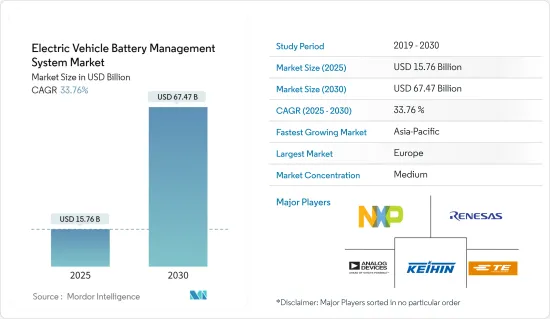
|
시장보고서
상품코드
1690859
전기자동차 배터리 관리 시스템 : 시장 점유율 분석, 산업 동향, 통계, 성장 예측(2025-2030년)Electric Vehicle Battery Management System - Market Share Analysis, Industry Trends & Statistics, Growth Forecasts (2025 - 2030) |
||||||
전기자동차 배터리 관리 시스템 시장 규모는 2025년에 157억 6,000만 달러, 2030년에는 674억 7,000만 달러에 달할 것으로 예측됩니다. 예측 기간 중(2025-2030년) CAGR은 33.76%를 나타낼 전망입니다.

세계 자동차 산업에 대한 COVID-19의 부정적인 영향에도 불구하고, 2020년 전기자동차 판매는 세계적으로 큰 성장을 보였습니다. 이는 주로 정부 보조금, 전기차 충전 인프라 확대, 연료 가격 상승으로 인한 것입니다. 2021년에도 비슷한 성장 동향이 보이며 예측 기간 동안 계속될 것으로 보입니다. 전염병은 세계 공급망을 혼란스럽게 하고 배터리 관리 시스템(BMS) 구성요소와 시스템의 생산과 납품에 지연과 부족을 일으키고 있습니다. 한편, 유행은 전기자동차의 보급을 가속화하고 배터리 관리 시스템(BMS) 기술 수요를 끌어 올리고 있습니다. 전반적으로, 유행이 배터리 관리 시스템(BMS) 산업에 미치는 장기적인 영향은 긍정적으로 일할 가능성이 높습니다.
중기적으로는 지속가능한 운송과 더 깨끗한 에너지에 대한 수요 증가가 배터리 전기자동차 수요를 뒷받침하고 있습니다. 차량의 항속 거리, 높은 초기 가격, 한정된 모델의 가용성, 지식 부족 등 소비자의 제약은 판매 촉진 활동과 정부의 법규제에 의해 해결되고 있습니다. 이러한 변수는 전기자동차 수요에 영향을 미치고 배터리 관리 시스템 시장을 견인합니다.
배터리 관리 시스템(BMS) 수요는 전기차 채용 증가에 따라 전 세계적으로 급성장할 것으로 전망되고 있습니다. 그러나 아시아태평양에서는 급속한 산업화와 도시화가 진행되고 있으며, 중국과 인도 등 국가에서는 전기자동차 수요가 증가하고 있기 때문에 BMS 시장은 아시아태평양이 선도할 것으로 예상됩니다. 북미와 유럽 등 다른 지역도 BMS 시장에서 큰 성장이 예상됩니다.
전기자동차 수요가 증가함에 따라 배터리의 화학적 특성과 재료의 기술적 진보로 이어지고 배터리의 안전성과 성능을 보장하기 위해 보다 정교하고 효율적인 BMS가 필요합니다.
전기자동차 배터리 관리 시스템 시장 동향
시장을 독점할 것으로 예상되는 배터리 전기자동차 부문
세계 각국의 정부는 전기자동차의 도입을 장려하는 정책을 적극적으로 내세우고 있습니다. 중국, 인도, 프랑스, 영국은 2040년까지 가솔린차와 디젤차를 폐기할 계획을 발표했습니다. EV 수요가 증가함에 따라 배터리 관리 시스템 수요도 점차 높아질 것으로 보입니다.
전동 이동성은 전 세계적으로 점차 확대되고 있기 때문에 화물 운송 회사도 기존 차량을 전기 추진 기반 차량으로 바꾸고 있습니다. OEM은 전기자동차의 로드맵을 재정의합니다. 이것은 목표 시장의 성장에 긍정적인 영향을 미칠 것으로 보입니다. 예를 들면
- 2022년 12월, 상용 플릿 시장을 위한 전기 소형 픽업 트럭의 제조에 주력하고 있는 로드스타운 모터스사는 풀 사이즈 BEV 픽업 트럭 「엔듀란스」를 CES의 모빌리티 인 하모니(MIH) 컨소시엄의 서 홀 부스 5274에 전시한다고 발표했습니다.
- 2022년 12월, 로스앤젤레스 세계공항(LAWA)은 이 공항의 완전한 전기자동차로의 전환에 중요한 단계가 되는 최초의 니콜라 토레 대형 배터리 전기자동차의 도착을 발표했습니다.
전기차 동향 증가도 향후 시장 성장의 원동력이 될 것으로 예상됩니다. BYD, Proterra, Tata, Volvo 등의 유명 기업은 다른 기업와 수입품에 대한 의존도를 줄이기 위해 사업을 전개하는 지역 전체에서 제품을 현지화하려고 합니다. 예를 들면
- 2022년 12월 볼보 카 말레이시아(VCM)는 XC40 Recharge Pure Electric에 이어 회사의 두 번째 BEV 모델인 C40 Recharge를 발표했습니다. C40은 볼보의 샤알람 공장에서 생산되는 현지조립(CKD) 모델로 2025년 12월 31일까지 정부의 CKD EV 우대조치의 혜택을 받습니다.
- 도요타 모터 유럽(TME)은 2022년 12월 프랑스의 도요타 유럽 설계 개발(ED2)이 유럽에서 설계한 풀 배터리 전기자동차 '토요타 bZ 컴팩트 SUV 컨셉'을 발표했습니다.
규제 당국은 연료 배출량을 줄이고 교통 안전을 개선하기 위해 엄격한 규제를 갖고 있습니다. 또한, 이산화탄소 배출과 에너지 지속가능한 운송에 대한 소비자의 추세는 예측 기간 동안 시장 침투를 위한 잠재적인 기회가 될 것으로 보입니다.
유럽이 시장에서 큰 점유율을 차지할 전망
전기자동차 추진 계획과 관련하여 독일은 현재 보다 엄격한 배출 기준을 충족하기 위한 전략을 시행하고 있습니다. 연방 정부의 기후 보호 프로그램은 주로 운송 혁신을 통해 2030년 기후 목표를 달성하는 것을 목표로 하고 있으며 전기 이동성에 중점을 둡니다. 클린카를 촉진하기 위해, 이 나라는 구매 보조금, 소유세, 사차세 등의 인센티브와 투자를 도입하고 있습니다.
경량화는 전기자동차 및 전기 제품 설계의 최우선 사항입니다. 경량화를 위해 2개 이상의 부품을 통합한 컴팩트한 모듈을 설계하는 기업은 거의 없습니다. 예를 들면
Hera는 2021년 4월 파워팩 48볼트를 발표했습니다. 이는 파워 일렉트로닉스와 배터리 관리를 하나의 제품에 통합한 것으로, 주행 킬로미터당 5-6그램의 CO2를 삭감합니다. HELLA가 중국의 셀 제조 업체와 공동으로 개발한 이 솔루션은 2024년 상하이에서 양산을 시작할 예정입니다.
정부는 또한 인프라 투자, 최신 저배출 가스차 및 제로 방출 차량의 보급을 촉진하는 광범위한 시책, EV 시장에서의 점유율 확대를 지원하는 장기 구매 우대 조치 등 보다 협력적인 정책으로 업계의 성장을 지원하고 있습니다. 이에 따라 예측 기간 동안 EV용 배터리 관리 시스템 시장 전망이 강화될 것으로 예상됩니다.
- 2023년 1월 중국 자동차 제조업체인 BYD는 전기차 시장 점유율이 확대되고 있는 영국에서 지난 분기부터 자동차 판매를 시작했습니다. 워런 버핏(Warren Buffett)의 버크셔 해서웨이(Berkshire Hathaway)가 지원하는 이 자동차 제조업체에 따르면 영국의 딜러 파트너는 펜드래곤(Pendragon), 아놀드 클락(Arnold Clark), 루커스(Lookers), LSH의 4사입니다.
- ST 마이크로 일렉트로닉스는 2021년 6월 Arrival과의 협업을 발표하고, 차재용 마이크로컨트롤러나 전원 및 배터리 관리 디바이스 등 Arrival의 자동차용 반도체 기술 및 제품을 제공합니다. Arrival사는 커넥티드 EV를 시장에 투입할 때 중요한 파트너 중 하나로 ST를 선택했습니다. Arrival은 모듈형 ECU 플랫폼에 ST의 안전한 차량용 마이크로컨트롤러를 채용하고, 스마트 파워 및 배터리 관리 디바이스를 포함한 다른 ST 기술도 채용하고 있습니다.
각 회사는 차량의 경량화를 위해 배터리 관리 시스템을 탑재한 새로운 배터리 모듈을 개발하고 있습니다. 예를 들면
2021년 6월, Leclanche SA는 M3이라는 새로운 세대의 리튬 이온 배터리 모듈을 개발했다고 발표했습니다. 이것은 기능적으로 안전한 마스터 배터리 관리 시스템 유닛과 통신하는 기능적으로 안전한 슬레이브 배터리 관리 시스템(BMS) 유닛을 갖추고 있습니다.
이러한 요인을 고려하면 전기자동차 배터리 관리 시스템 수요는 예측 기간 동안 그래프의 플러스 측면을 유지할 것으로 예상됩니다.
전기자동차 배터리 관리 시스템 산업 개요
전기자동차 배터리 관리 시스템 시장은 Renesas Electronics Corporation, NXP Semiconductors, Keihin Corporation, TE Connectivity, Analog Devices Inc. 등 주요 기업에 의해 지배되고 있습니다. 게다가 이 시장은 신규 진출기업에 매우 매력적인 경향이 있으며, 시장에서 사업을 전개하는 기업은 경쟁 우위를 얻기 위해 첨단 기술 투입에 주력하고 있습니다. 예를 들면
- 2022년 5월, 볼그워너 잉크는 비공개 국제 자동차 제조업체로부터 회사의 배터리 관리 시스템(BMS)을 공급하는 계약을 획득했다고 발표했습니다. 볼그워너의 BMS 기술은 배터리 팩의 성능, 안전성, 수명을 향상시킵니다.
- 2022년 1월, FPT Industrial은 고객의 요구에 맞게 맞춤형 배터리 관리 시스템을 갖춘 2개의 전자 액슬과 배터리 팩을 발표했습니다. 니콜라 트레용으로 설계된 일체형 e-액슬을 전시했습니다. GVW44톤까지 차량에 대응하는 듀얼 전동 모터 액슬은 각 모터의 최대 출력 420kW, 최대 토크 900Nm에서 높은 성능과 효율을 보장합니다.
- 2021년 10월 발라드 파워 시스템즈와 포시 파워사는 대형 수소 이동성 용도을 위한 성능, 비용 및 설치성을 최적화한 연료전지 및 배터리의 완전 통합 솔루션을 개발하기 위한 전략적 파트너십에 관한 각서에 서명했다고 발표했습니다.
기타 혜택
- 엑셀 형식 시장 예측(ME) 시트
- 3개월간의 애널리스트 및 지원
목차
제1장 서론
- 조사의 전제조건
- 조사 범위
제2장 조사 방법
제3장 주요 요약
제4장 시장 역학
- 시장 성장 촉진요인
- 시장 성장 억제요인
- 업계의 매력도 - Porter's Five Forces 분석
- 공급기업의 협상력
- 소비자의 협상력
- 신규 참가업체의 위협
- 대체품의 위협
- 경쟁 기업간 경쟁 관계
제5장 시장 세분화
- 컴포넌트별
- 집적회로
- 컷오프 FET와 FET 드라이버
- 온도 센서
- 연료계, 전류 측정 디바이스
- 마이크로컴퓨터
- 기타 컴포넌트
- 추진 유형별
- 배터리 전기자동차
- 하이브리드 전기자동차
- 차량 유형별
- 승용차
- 상용차
- 지역별
- 북미
- 미국
- 캐나다
- 기타 북미
- 유럽
- 독일
- 영국
- 프랑스
- 러시아
- 스페인
- 기타 유럽
- 아시아태평양
- 중국
- 인도
- 일본
- 한국
- 기타 아시아태평양
- 남미
- 브라질
- 아르헨티나
- 기타 남미
- 중동 및 아프리카
- 아랍에미리트(UAE)
- 사우디아라비아
- 기타 중동 및 아프리카
- 북미
제6장 경쟁 구도
- 벤더의 시장 점유율
- 기업 프로파일
- Infineon Technologies AG
- Silicon Laboratories
- NXP Semiconductors
- Vitesco Technologies
- TE Connectivity
- Renesas Electronics Corporation
- Keihin Corporation
- Texas Instruments Incorporated
- Analog Devices Inc.
- Visteon Corporation
제7장 시장 기회와 앞으로의 동향
SHW 25.04.07The Electric Vehicle Battery Management System Market size is estimated at USD 15.76 billion in 2025, and is expected to reach USD 67.47 billion by 2030, at a CAGR of 33.76% during the forecast period (2025-2030).

Despite the negative COVID-19 impact on the global automotive industry, electric vehicle sales for the year 2020 witnessed significant growth worldwide. This was primarily attributed to government subsidies, expanding electric vehicle charging infrastructure, and a rise in fuel prices. The same growth trend was witnessed for 2021 and will likely continue during the forecast period. The pandemic has disrupted global supply chains, causing delays and shortages in the production and delivery of BMS components and systems. On the other hand, the pandemic has also accelerated the adoption of electric vehicles, which has driven the demand for BMS technology. Overall, the long-term impact of the pandemic on the BMS industry is likely to be positive.
Over the medium term, rising demand for sustainable transportation and cleaner energy has engaged the demand for battery electric vehicles. Consumer constraints such as vehicle range, greater upfront prices, limited model availability, and lack of knowledge are being solved by promotional activities and government legislation. These variables will have an impact on the demand for electric vehicles, which will drive the battery management system market.
The demand for battery management systems (BMS) is expected to grow rapidly across the globe, driven by the increasing adoption of electric vehicles. However, Asia Pacific is expected to lead the market for BMS due to the rapid industrialization and urbanization in the region, as well as the increasing demand for electric vehicles in countries such as China and India. Other regions, such as North America and Europe, are also expected to experience significant growth in the BMS market.
The growing demand for electric vehicles will lead to technological advancements in battery chemistry and materials, which will require more sophisticated and efficient BMS to ensure the safety and performance of batteries.
Battery Management System for Electric Vehicle Market Trends
Battery Electric Vehicle Segment Anticipated to Dominate the Market
Governments around the world have been proactive in enacting policies to encourage the adoption of electric vehicles. China, India, France, and the United Kingdom have announced plans to phase out petrol and diesel vehicles before 2040 completely. As the demand for EVs increases, the demand for battery management systems will also increase gradually.
Electric mobility is gradually growing around the world, owing to which the goods transportation companies are also converting their existing fleets into electric propulsion-based vehicles. OEM is redefining its roadmap for electric vehicles. This will positively impact the target market growth. For instance,
- In December 2022, Lordstown Motors Corp., which focuses on building electric light-duty pickup trucks for the commercial fleet market, announced that the Endurance full-size BEV pickup truck will be on display at CES in the West Hall Booth 5274 of the Mobility in Harmony (MIH) Consortium.
- In December 2022, Los Angeles World Airports (LAWA) announced the arrival of its first Nikola Tre heavy-duty battery-electric vehicle, a significant step forward in the airport's transition to a fully electric fleet.
The increase in the trend of electric vehicles is also expected to drive market growth in the future. Prominent companies such as BYD, Proterra, Tata, Volvo, and others are trying to localize their products across the regions they operate to reduce the dependence on other players and imports. For instance,
- In December 2022, Volvo Car Malaysia (VCM) unveiled the C40 Recharge, the company's second BEV model after the XC40 Recharge Pure Electric. The C40, as a locally assembled (CKD) model from Volvo's Shah Alam plant, will also benefit from the government's CKD EV incentives until December 31, 2025.
- In December 2022, Toyota Motor Europe (TMEs unveiled the Toyota bZ Compact SUV Concept, a full-battery-electric vehicle designed in Europe by Toyota European Design and Development (ED2) in France.
Regulatory bodies have laid down stringent regulations about bringing down fuel emissions and increasing road safety. Furthermore, Consumer inclination toward carbon emission and energy-sustainable transportation will provide potential opportunities for target market penetration over the forecast period.
Europe Expected to Hold Significant Share in the Market
In terms of pro-electric plans, Germany is now implementing strategies to meet stricter emission standards. The federal government's climate protection program, which aims to meet its 2030 climate targets primarily through transportation innovation, places a premium on electric mobility. To promote clean cars, the country is introducing incentives and investments such as a purchase grant, ownership tax, and company car tax.
Weight reduction is a top priority in the design of electric vehicles and products. Few companies are designing compact modules integrating two or more components to save weight. For example,
Hella's introduced the PowerPack 48 Volt in April 2021, which combines power electronics and battery management in one product and saves 5 to 6 grams of CO2 per kilometer driven. This solution, which HELLA is developing in collaboration with a Chinese cell manufacturer, is set to enter series production in Shanghai in 2024.
The government is also aiding the industry growth with more supportive policies: investment in infrastructure; broader measures to encourage uptake of the latest, low and zero-emission cars; and long-term purchase incentives to help the country grow its share in the EV market. This is expected to bolster the market prospects for battery management systems for EVs during the forecast period.
- In January 2023, BYD, a Chinese automaker, began selling vehicles in the United Kingdom this quarter, where electric vehicles are gaining market share. According to the automaker, backed by Warren Buffett's Berkshire Hathaway, it has appointed four UK dealer partners in Pendragon, Arnold Clark, Lookers, and LSH.BYD's first model will be the Atto 3 SUV, and more dealer partners and pricing will be announced in the coming weeks.
- In June 2021, STMicroelectronics announced its collaboration with Arrival to provide semiconductor technologies and products for Arrival's vehicles, including automotive microcontrollers and power and battery-management devices. Arrival has chosen ST as one of its key partners in bringing its connected Evs to market. Arrival has selected ST's secure automotive microcontrollers for their modular ECU platform, as well as other ST technologies, including smart-power and battery-management devices.
Although companies are developing new battery modules with a battery management system to reduce the weight of the vehicles. For instance,
In June 2021, Leclanche SA announced that it had developed a new generation of lithium-ion battery modules called M3; it is fitted with a functionally safe slave battery management system (BMS) unit which communicates with a functionally safe master battery management system unit.
Considering these factors demand for Electric Vehicle Battery Management Systems is anticipated to remain on the positive side of the graph during the forecast period.
Battery Management System for Electric Vehicle Industry Overview
The Electric Vehicle Battery Management System Market is dominated by several key players such as Renesas Electronics Corporation, NXP Semiconductors, Keihin Corporation, TE Connectivity, Analog Devices Inc., and others. Moreover, the market tends to be highly attractive for new players, and companies operating in the market have been focusing on launching advanced technologies to gain a competitive advantage. For instance,
- In May 2022, BorgWarner Inc. announced that the company had got a deal from an undisclosed international vehicle manufacturer to supply its Battery Management System (BMS). Model years beginning in the middle of 2023 will be the first to come with the new BorgWarner BMS technology, which improves the performance, security, and lifespan of battery packs.
- In January 2022, FPT Industrial announced presenting two e-axles and a battery pack with a Battery Management System customized to meet customer needs. It displayed an integrated e-Axle designed for the Nikola Tre. A dual-electric motor axle for GVW vehicles up to 44 tons guarantees high performance and efficiency with a maximum power of 420 kW and a maximum torque of 900 Nm for each motor.
- In October 2021, Ballard Power Systems and Forsee Power announced signing a memorandum of understanding (MOU) for a strategic partnership to develop fully integrated fuel cell and battery solutions optimized for performance, cost, and installation for heavy-duty hydrogen mobility applications.
Additional Benefits:
- The market estimate (ME) sheet in Excel format
- 3 months of analyst support
TABLE OF CONTENTS
1 INTRODUCTION
- 1.1 Study Assumptions
- 1.2 Scope of the Study
2 RESEARCH METHODOLOGY
3 EXECUTIVE SUMMARY
4 MARKET DYNAMICS
- 4.1 Market Drivers
- 4.2 Market Restraints
- 4.3 Industry Attractiveness - Porter's Five Forces Analysis
- 4.3.1 Bargaining Power of Suppliers
- 4.3.2 Bargaining Power of Consumers
- 4.3.3 Threat of New Entrants
- 4.3.4 Threat of Substitute Products
- 4.3.5 Intensity of Competitive Rivalry
5 MARKET SEGMENTATION (Market Size in Value USD Million)
- 5.1 By Components
- 5.1.1 Integrated Circuits
- 5.1.2 Cutoff FETs and FET Driver
- 5.1.3 Temperature Sensor
- 5.1.4 Fuel Gauge/Current Measurement Devices
- 5.1.5 Microcontroller
- 5.1.6 Other Components
- 5.2 By Propulsion Type
- 5.2.1 Battery Electric Vehicles
- 5.2.2 Hybrid Electric Vehicles
- 5.3 By Vehicle Type
- 5.3.1 Passenger Car
- 5.3.2 Commercial Vehicles
- 5.4 By Geography
- 5.4.1 North America
- 5.4.1.1 United States
- 5.4.1.2 Canada
- 5.4.1.3 Rest of North America
- 5.4.2 Europe
- 5.4.2.1 Germany
- 5.4.2.2 United Kingdom
- 5.4.2.3 France
- 5.4.2.4 Russia
- 5.4.2.5 Spain
- 5.4.2.6 Rest of Europe
- 5.4.3 Asia-Pacific
- 5.4.3.1 China
- 5.4.3.2 India
- 5.4.3.3 Japan
- 5.4.3.4 South Korea
- 5.4.3.5 Rest of Asia-Pacific
- 5.4.4 South America
- 5.4.4.1 Brazil
- 5.4.4.2 Argentina
- 5.4.4.3 Rest of South America
- 5.4.5 Middle-East and Africa
- 5.4.5.1 United Arab Emirates
- 5.4.5.2 Saudi Arabia
- 5.4.5.3 Rest of Middle-East and Africa
- 5.4.1 North America
6 COMPETITIVE LANDSCAPE
- 6.1 Vendor Market Share
- 6.2 Company Profiles
- 6.2.1 Infineon Technologies AG
- 6.2.2 Silicon Laboratories
- 6.2.3 NXP Semiconductors
- 6.2.4 Vitesco Technologies
- 6.2.5 TE Connectivity
- 6.2.6 Renesas Electronics Corporation
- 6.2.7 Keihin Corporation
- 6.2.8 Texas Instruments Incorporated
- 6.2.9 Analog Devices Inc.
- 6.2.10 Visteon Corporation



















